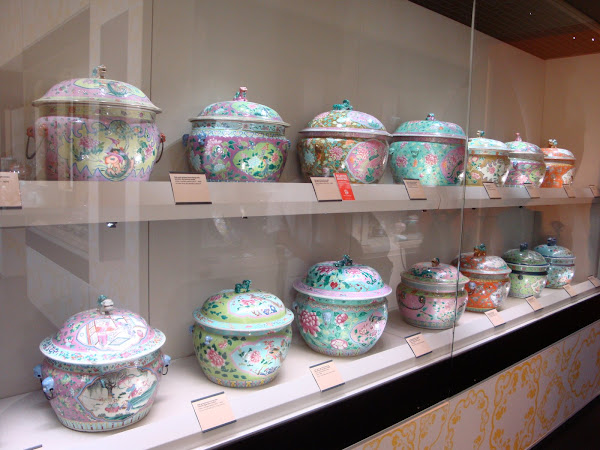 The main entrance at the front of the building will give you a feel of what it's like inside. Very colorful and pretty, just the way I like it :)
The main entrance at the front of the building will give you a feel of what it's like inside. Very colorful and pretty, just the way I like it :)
 If I remember correctly, there are ten galleries over three floors. We were in time for the guided tour at 2pm, which started at the 'Origins' gallery on the ground floor. This was the first time I ever followed a guided tour, and I must say I liked it very much! The lady was very sweet and entertaining, and we learnt pretty much from her with regards to the life and rituals of the peranakans.
If I remember correctly, there are ten galleries over three floors. We were in time for the guided tour at 2pm, which started at the 'Origins' gallery on the ground floor. This was the first time I ever followed a guided tour, and I must say I liked it very much! The lady was very sweet and entertaining, and we learnt pretty much from her with regards to the life and rituals of the peranakans.As a kid at heart, there is one thing I have to mention. If you are so inclined, you may get these gold-colored stickers from the front desk at $1 each (free for kids below 12). These are for you to emboss various motifs and designs on, at one of the many embossing stations around the museum, and kept as a souvenir.
The main reason that sparked my trip to the museum was a sudden interest in beading. Not any type of beading, but peranakan beading, and particularly shoes. Which woman doesn't like shoes?
Shoe beading is a very time-consuming activity, but as peranakan women in those days weren't expected to wander outside the house, they had to find something to occupy themselves with. Sewing, cooking and other feminine and domestic skills were the criteria these women were judged on in those days.
The main attraction at the exhibition was this tablecloth made out of about a million beads. If a pair of shoes take about 90 hours to bead, I wonder how many people and how many hours it took to complete this exquisite piece.
I was delighted to see a display of crockery, since collecting pretty colorful floral pieces is another of my interest. Though I find some peranakan color combinations a little too loud for my liking, prefering pastel shades instead, I found many of those on display really sweet nonetheless, and could very well find a place on my shelf.
 They also had on display, dining pieces from a few prominent families. A measure of wealth, it meant that the larger the set a family had, the richer they were.
They also had on display, dining pieces from a few prominent families. A measure of wealth, it meant that the larger the set a family had, the richer they were.Another item that caught my attention were the sireh sets. These are so beautiful that I'm seriously considering getting one for myself. It was rumoured that a sireh set could ward off evil spirits and as such, one was placed in every newlyweds' room. In addition, a sireh set was also used as a face-saving gadget when a boy's mother visits a girl's parents to ask for her hand in marriage. If the request for marriage is denied, the girl's parents would politely refuse the sireh, saying that their teeth hurt too much to be chewing sireh or give some similar excuse.
 Clothes. Another of my fetishes. Cheongsams, kimonos, kebayas. Basically any traditional apparel. I spent quite some time admiring the detailed patterns and embroidery. The fact that my paternal grandmother did not leave us her clothing had been a sore spot for some time, and unfortunately, that was the only indication that I had a peranakan heritage.
Clothes. Another of my fetishes. Cheongsams, kimonos, kebayas. Basically any traditional apparel. I spent quite some time admiring the detailed patterns and embroidery. The fact that my paternal grandmother did not leave us her clothing had been a sore spot for some time, and unfortunately, that was the only indication that I had a peranakan heritage.It took us about an hour or two to view the entire exhibition and on our way out, we paid a visit to the two tiny shops outside the museum. These shops sell a limited range of peranakan goods, but there are a few rather eye-catching albeit expensive items. I was eyeing a mirror with a decorative tile as well as a beaded stamp , but needing to ponder over my purchases as usual, I decided I would return another day to get them.

 As we left, we bade farewell to their resident cat, or at least the sculpture of it. Happy day! I would highly recommend this place. After three decades of living in Singapore, I finally made the daytrip.
As we left, we bade farewell to their resident cat, or at least the sculpture of it. Happy day! I would highly recommend this place. After three decades of living in Singapore, I finally made the daytrip. 









No comments:
Post a Comment
Thanks for reading my blog!